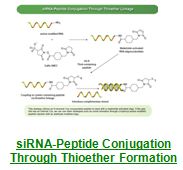High Quality Custom Peptide-siRNA synthesis and Conjugation Services
All of our siRNA-peptide conjugates include: synthesis and modification of siRNA and peptide conjugation; each biopolymer is carefully monitored for its sequence integrity and systematically controlled by PAGE or mass spectrometry analysis. Quantity is validated by UV absorbance at 260 nm.
Specification of siRNA-Peptide Conjugates
Price
The price varies depending on different methods used in obtaining peptide-oligo conjugate. Please contact us for a quotation.
Chemistry
Double-stranded siRNA is generally sufficiently stable to be used without modification, but are usually heavily modified with nucleoside analogs for in vivo use. The 5', internal or 3'-terminus of an siRNA oligos can be covalently linked to N-, internal or C-terminus of a peptide using preactivated small molecules with functional groups residing in peptides. Oligos such as amine, thiol, carboxylate,hydroxyl, aldehyde and ketone, active hydrogen, photo-chemical and cycloaddition reacting and cross-linking with one another through variety of different conjugation chemistries that include either stable or cleavable linkage. Although, the price for using other strategies for making peptide-oligo conjugate is the same, the price for obtaining other modified peptides, oligo and cross-linker includes either stable or cleavable linkages, or higher additional spacers.

Specification
Product is HPLC purified and usually over 85-95% pure
Procedure
Functionalization of oligos and peptides are manufactured under strict, quality control process. Analytical HPLC and MS analyses are performed in every development cycle. Depending on the type of conjugation chemistry we use, after buffer exchange (if necessary), conjugates undergo gel filtration or use of the centrifugal concentrator to remove excess cross-linking reagents and oligonucleotides. Then, by either size-exclusion chromatography (SEC) or reverse phase HPLC, they may also be used to either remove excess reagents or isolate and characterize the cross-linked product. Once the product has been purified, it may be subject to many different types of studies including spectroscopic (MALDI-TOF, ESI, LC-MS Fluorescence) and electrophoresis.
QC (quality control) and QA (quality assurance) procedures are also followed independently to guarantee you the highest quality of every delivered conjugates. Final quantity is systematically validated by UV absorbance at 260 nm. Moreover, our dedicated technical account managers will guide your project through every step of the process and constantly keep you informed of the latest project progress.
Delivery Specifications
The typical delivery consists of lyophilized sample in individual fully labeled vials.The shipment also contains COA, MS, HPLC and/or other analytical data. Additional analytical data is also available upon request.
Contact our Technical Service Center at 800.227.0627 or contact us online with your detailed oligo-peptide project specifications, a project manager will be assigned to help you with design and develop an appropriate synthetic method for your specific needs.
Ordering and Submitting Requests for Bioconjugation Services
For us to better understand your customized project, please complete our Bioconjugation Service Questionnaire. The more our chemists understand your project’s needs, the more accurate your provided feedback will be. Providing us with your project’s details enables us to recommend the best reagents to use for your project. The most useful and readily available tools for bioconjugation projects are cross-linking reagents. A large number of cross-linkers, also known as bifunctional reagents, have been developed. There are several ways to classify the cross-linkers, such as the type of reactive group, hydrophobicity or hydrophilicity and the length of the spacer between reactive groups. Other factors to consider are whether the two reactive groups are the same or different (i.e. heterobifunctional or homobifunctional reagents), spacer is cleavable and if reagents are membrane permeable or impermeable. The most accessible and abundant reactive groups in proteins are the ϵ-amino groups of lysine. Therefore, a large number of the most common cross-linkers are amino selective reagents, such as imidoesters, sulfo-N-hydroxysuccinimide esters and N-hydroxysuccinimide esters. Due to the high reactivity of the thiol group with N-ethylmaleimide, iodoacetate and a-halocarbonyl compounds, new cross-linkers have been developed containing maleimide and a-carbonyl moieties. Usually, N-alkylmaleimides are more stable than their N-aryl counterparts.
In addition to the reactive groups on the cross-linkers, a wide variety of connectors and spacer arms have also been developed. The nature and length of the spacer arm play an important role in the functionality. Longer spacer arms are generally more effective when coupling large proteins or those with sterically protected reactive side-chains. Other important considerations are the hydrophobicity, hydrophilicity and the conformational flexibility. Long aliphatic chains generally fold on themselves when in an aqueous environment, making the actual distance spanned by such linker arms less than expected. Instead, spacers containing more rigid structures (for example, aromatic groups or cycloalkanes) should be used. These structures, however, tend to be very hydrophobic which could significantly decrease the solubility of the modified molecules or even modify some of their properties. In such cases, it is recommended to choose a spacer that contains an alkyl ether (PEO) chain. Bio-Synthesis offers several cross-linkers with PEO chains, such as thiol-binding homobifunctional reagents, heterobifunctional bases and their derivatives.
Within 3-5 days upon receiving your project scope, we will provide you an appropriate quotation. An order can be placed with PO (Purchase Order) or major credit cards (  ). Your credit card will be billed under Bio-Synthesis, Inc.
). Your credit card will be billed under Bio-Synthesis, Inc.